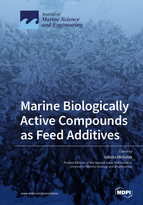Marine Biologically Active Compounds as Feed Additives
A special issue of Journal of Marine Science and Engineering (ISSN 2077-1312). This special issue belongs to the section "Marine Biology".
Deadline for manuscript submissions: closed (30 June 2020) | Viewed by 45707
Special Issue Editor
Interests: the technology of waste biomass management for products for agriculture; biosorption/bioaccumulation of metal ions by biomass; production of feed additives/components of fertilizers with microelements via biosorption; biosorption of toxic metal ions from wastewater; composting of biomass; extraction of biologically active compounds from algae; the technology of algal extracts and their potential applications in agriculture (plant growth biostimulants, dietary feed supplements); production of algal biochar via pyrolysis and its properties; germination tests; pot experiments; field trials
Special Issues, Collections and Topics in MDPI journals
Special Issue Information
Dear Colleagues,
The purpose of this Special Issue is to publish high-quality research papers as well as review articles addressing the recent advances in the use of marine bioactives in animal nutrition. The marine environment constitutes a relatively untapped source of biologically active compounds that can be applied in various areas, such as improvement of animal performance, health maintenance, and diseases prevention. Numerous marine-based compounds isolated from marine organisms (algae, invertebrates, vertebrates, microorganisms) have diverse biological activities, such as antioxidative, anti-inflammatory, antibacterial, antifungal, antiviral, etc., that can be beneficial to animal health. Additionally, the application of marine bioactives as feed additives can increase the nutritional value of products of animal origin. The optimal use of marine resources in feeds/feed additives also requires their suitable processing, including the application of novel extraction techniques that will protect the bioactives from degradation. Topics concerning the development and the production of innovative, natural feed/feed additives that will improve animal health and performance are also welcomed.
Dr. Izabela Michalak
Guest Editor
Manuscript Submission Information
Manuscripts should be submitted online at www.mdpi.com by registering and logging in to this website. Once you are registered, click here to go to the submission form. Manuscripts can be submitted until the deadline. All submissions that pass pre-check are peer-reviewed. Accepted papers will be published continuously in the journal (as soon as accepted) and will be listed together on the special issue website. Research articles, review articles as well as short communications are invited. For planned papers, a title and short abstract (about 100 words) can be sent to the Editorial Office for announcement on this website.
Submitted manuscripts should not have been published previously, nor be under consideration for publication elsewhere (except conference proceedings papers). All manuscripts are thoroughly refereed through a single-blind peer-review process. A guide for authors and other relevant information for submission of manuscripts is available on the Instructions for Authors page. Journal of Marine Science and Engineering is an international peer-reviewed open access monthly journal published by MDPI.
Please visit the Instructions for Authors page before submitting a manuscript. The Article Processing Charge (APC) for publication in this open access journal is 2600 CHF (Swiss Francs). Submitted papers should be well formatted and use good English. Authors may use MDPI's English editing service prior to publication or during author revisions.






